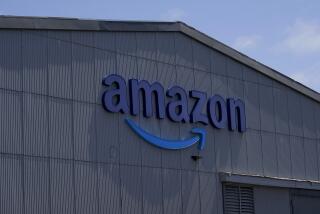Amazon.com unveils the Fire Phone, its first smartphone

WATCH VIDEO: The device has five front-facing cameras for facial tracking and a Dynamic Perspective view that changes as you move it.
Amazon.com has officially launched the Fire Phone, its first smartphone, after years of rumors.
Chief Executive Jeff Bezos took to the stage in Seattle shortly after 10:30 a.m. PDT to unveil the smartphone, which boasts a 4.7-inch screen, 13-megapixel rear-facing camera and five front-facing cameras.
The smartphone costs $200 for a 32-gigabyte version and $300 for a 64GB version, both with a two-year contract -- a higher-than-expected price tag given Amazon’s history of pricing its hardware relatively cheap. AT&T will be the exclusive carrier for the phone.
Bezos said the company put a “huge effort” into perfecting the design of the phone, which is black and closely resembles the look of the iPhone 5s.
But apart from its specs, the Fire Phone is at its core a hub for all things Amazon.
The Amazon smartphone was expected to integrate many of Amazon’s various interests in shopping, reading, music and video. Sure enough, the Fire Phone takes all of those into account.
For one, it makes shopping for products on Amazon easier. Bezos showed off a built-in feature called Firefly, which can recognize images, products, text and audio and connect smartphone users with a way to buy those items.
For example, a user can take a photo of a retail product -- such as a book, DVD or CD -- with the Fire Phone, and it will then find that item in its database and provide details and purchasing options. Taking a photo of a book will pull up a screen that enables the user to buy that title as a Kindle e-book, a hard copy via Amazon.com or as an audiobook.
Firefly recgonizes more than a hundred million items, Amazon said. There is a dedicated Firefly button on the side of the phone. Firefly also works with voice activation, can recognize music and identify artwork, Web and email addresses, phone numbers and QR and bar codes.
Wednesday’s media event took place at Fremont Studios in Seattle and lasted about 90 minutes.
“Can we build a better phone for our most engaged customers?” Bezos asked the crowd, made up of media and consumers. “Can we build a better phone for Amazon Prime members?”
Another big feature of the Fire Phone is Amazon’s Dynamic Perspective, which changes the view of an image by using a new sensor system to respond to the way users hold, view and move the phone.
Dynamic Perspective recognizes where a user’s head is relative to the device, which Bezos said will enable it to offer customers a more immersive experience, one-handed navigation and gestures “that actually work.”
It also responds to tilting motions, which can make the screen scroll faster.
The phone has Amazon’s Mayday feature built in, so anytime a user needs help using the phone, he or she can press the Mayday button and be connected to a customer support rep in 15 seconds or less 24/7, Bezos said.
He also showed off unfiltered images taken with the Fire Phone cameras and compared them with photos taken with the Samsung S5 and the iPhone 5s. The Amazon photos did appear to be cleaner and crisper, especially in low-light situations.
Fire Phone users will receive free unlimited photo storage on Amazon’s cloud drive. They’ll also have the ability to take a photo even when the screen is off.
Other highlights: The phone comes with dual stereo speakers, giving it “virtual surround sound”; earbuds made with flat cables for tangle-free design; Gorilla Glass on both sides; and a quad-core 2.2-gigahertz processor and 2GB RAM.
“Fire Phone puts everything you love about Amazon in the palm of your hand -- instant access to Amazon’s vast content ecosystem and exclusive features,” Bezos said in a statement.
As part of the launch, Amazon said it was offering 12 months of Amazon Prime free with the purchase of a Fire Phone.
Amazon faces a major battle to get the attention of consumers, who have overwhelmingly settled on Apple or Samsung phones and have spent years downloading apps and personalizing their devices.
The odds of a third player breaking through, as Microsoft has learned with its Windows Mobile phones, is a long shot for even companies with deep pockets. The once-ubiquitous BlackBerry, meanwhile, all but disappeared during the last few years.
According to ComScore, 167.9 million people in the U.S. owned smartphones during the three months ended in April. Apple was the No. 1 smartphone maker, with 41.4% of the market. Samsung followed with 27.7%.
LG, Motorola and HTC rounded out the top five, each with market share in the single digits.
Industry analyst Jeff Kagan said the Fire Phone looks to primarily be about keeping shoppers wedded to the Amazon brand by “selling more stuff.”
“The question is, a few years from now, will this Fire Phone be remembered as one of the wireless [industry’s] key moments, like when the first Apple iPhone or Google Android or Samsung Galaxy was introduced?” he said. “Or will this not be as big a smartphone competitor, but another way for Amazon.com customers to shop?”
Follow Andrea Chang on Twitter.







